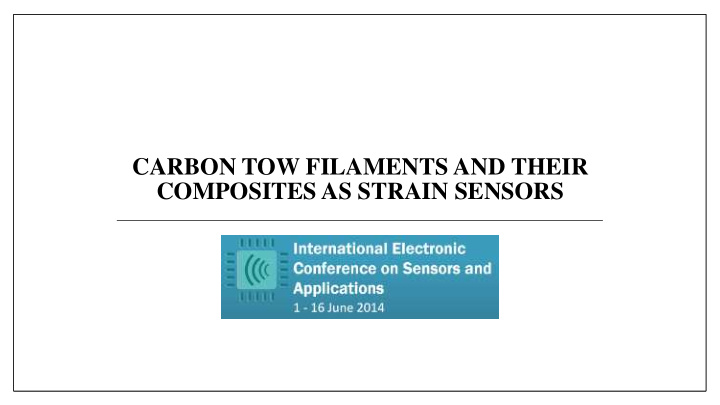



CARBON TOW FILAMENTS AND THEIR COMPOSITES AS STRAIN SENSORS
AUTHORS Catarina Lopes 1, * , Rita Salvado 1, *, Pedro Araújo 1 , Fernando Velez 1 , João Gomes 1 Leszek Szojda 2 , and Marcin Gorski 2 1 Unidade de Investigação Materiais Têxteis e Papeleiros, Universidade da Beira Interior, 6201-001 Covilhã, Portugal; E-Mails: kate_cial@sapo.pt (C.L.); rita.salvado@ubi.pt (R.S); paraujo@ubi.pt (P.A.); fjv@ubi.pt (F.V.); castro.gomes@ubi.pt (C.G.) 2 Faculty of Civil Engineering, Silesian University of Technology, ul.Akademicka 5, 44-100 Gliwice, Poland; E-Mails: Leszek.Szojda@polsl.pl (L.S.); Marcin.Gorski@polsl.pl (M.G.) * Author to whom correspondence should be addressed; E-Mail: kate_cial@sapo.pt (C.L.); rita.salvado@ubi.pt (R.S.) Tel.: +351-275-319-852; Fax: +351-275-319-723 .
Introduction Structural Health Monitoring of the building structure, sensing low strains by measuring the • electrical resistance of the strengthening composite material. Use of Carbon Filaments Epoxy Composites for both strengthening and monitoring of the • structure. Self-sensing technique based on the change of the electrical resistance of the composite • caused by deformation and damage. The strain monitoring by electrical resistance measurement has been based in two types of • measurement: the through-thickness conductivity and the longitudinal conductivity (along the filament direction) measurement.
EXPERIMENTAL METHODS Materials and specimens
Carbon tow • PAN-based carbon filaments from the company SGL grou • The filaments are embedded in the epoxy-resin S&P Resin 55 Table 1. Carbon continuous filament tow properties. Tensile Single Number Fineness of Tensile Elongation at Filament Density SIGRAFIL C type strength filament [g/m 3 ] filaments tow [tex] modulus [GPa] break [%] diameter [µm] [GPa] resistivity [µΩ] C30 TO50 EPY 50k 3200 4.0 253 1.6 7 1.80 15 (Enhanced modulus)
Carbon composite specimens to test at the dynamometer The following table shows the general characteristics of the specimens made to test in the • dynamometer. Table 2. Dynamometer specimens Carbon filament tow without resin with 50k number of filaments (3 performed tests in the same sample) Carbon filament tow in epoxy-resin with 3 days <50k <50k with eight cuts <50k/<50k <50k long 50k with six cuts Carbon filament tow in epoxy-resin with 7 days 50k/50k <50k/50k <50k with 8 cuts 1 Transversal/1 longitudinal
EXPERIMENTAL METHODS Performed tests
Tensile-strain tests while recording the electrical resistance • Specimens were tested in the dynamometer (Adamel Lhomargy DY35) and at the same time the electrical resistance was recorded. • Electric resistance recorded with a multimeter (Keithley 197A) connected to the extremities of the probe. Table 2. Dynamometer tests characteristics. Initial Length 500mm Velocity of test 1mm/min
Tensile-strain tests while recording the electrical resistance Figure 1. ( a ) Example of probe in the dynamometer. (b) Emphasis on the connections to measure the electrical resistance. (a) (b)
RESULTS And discussions
• For all tested specimens the small strains cause an increase in the electrical resistance. The initial resistance of these 500 mm long tows was deliberately diverse, varying from 9 Ω (for the thick tow with eight cuts) to 350 Ω (for the thin tow with long length - snake design). • Despite this large range of magnitude of the electrical resistance, in all specimens the fractional change of the electrical resistance was sensing the deformation. But, as expected, higher electrical resistances enhance this sensing ability. Figure 2. Fractional increase in electrical resistance (∆R/R0), in percentage, as function of the strain.
• The increase of electrical resistance caused by an increase in strain may occur because the filaments, that are covered with the epoxy-resin, become more aligned and thus the contact points between filaments decrease. • The introduction of deliberated disruptions on the conductive pathway, by random cuts, (<50k with 8 cuts) enhanced the sensing ability. Similarly, the sensing of strain by measuring the contact electrical resistance (<50k/>50k) shows a very good performance. Figure 2. Fractional increase in electrical resistance (∆R/R0), in percentage, as function of the strain.
• The importance of the reinforce of the concrete for that the thicker the carbon filaments the better we can provide the necessary performance of the building structures, • In this case the same reinforce material can become a strain sensor to detect small deformation on the concrete and reinforce building structures.
Conclusions For all tested specimens, the electrical resistance of the carbon filaments epoxy composites change with low strains, increasing with an increase of strain. Carbon filaments and their composites may have the ability to become strain sensors for monitoring buildings, roads, bridges … The usual carbon strengthening materials may act as self-sensing technique for the health monitoring of buildings. This way sensors are part of a multi-function material that is light weight and low cost. By introducing some specific and simple designs on the geometry of the filaments that integrate the strengthening textile fabric, the self-sensing ability of the fabric might be improved.
ACKNOWLEDGEMENTS The authors acknowledge the European Union for financing the project 251373 (FP7-PEOPLE-2009-IAPP) – INSYSM - Intelligent Systems for Structures Strengthening and Monitoring.
THANKS FOR YOUR ATTENTION
Recommend
More recommend